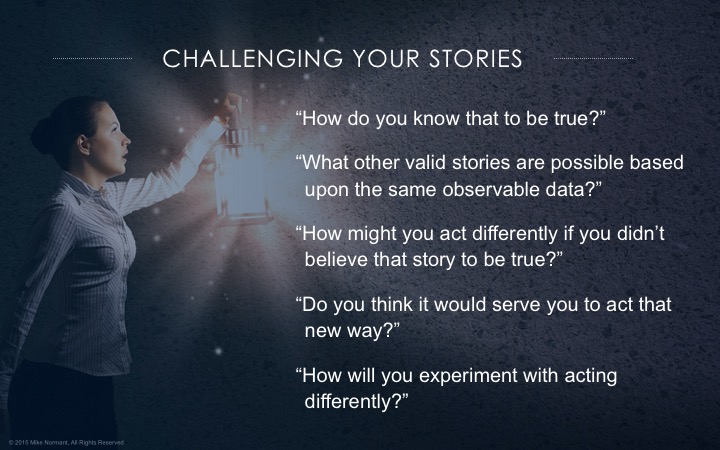We are sense-making creatures. Our brains are wired to help us navigate our lives by creating stories to make sense of our world, our day-to-day experiences. Having self-awareness to see when you are telling yourself a story is powerful. Even more powerful is having a simple tool to help you challenge those stories to assess their level of “truthfulness.”
In today’s post (Challenging Your Stories, Part II of II), I’ll provide an example of using the approach that I shared in last month’s blog (Part I).
How We Operate – The Ladder of Inference
In last month’s blog, I highlighted that we each “climb” our own unique Ladder of Inference (inside our heads) which is how we generate our stories (i.e., assumptions, conclusions, beliefs, etc.). This happens so seamlessly that we tend to operate as if our stories are facts, or what I call capital T Truth. In fact, these stories are our truth, with a small t.
A Simple Example
I assume you can relate to this one. You’ve sent an email to somebody (Jack) and did not receive a response. Based on this you know that Jack is mad at you. It’s the Truth. Hence, you act accordingly. You start to avoid Jack in order to ensure you don’t have an unpleasant encounter. After all, he is mad at you.
Challenging Your Stories – An Example
Last month we introduced a set of five questions that can be used to challenge your stories. Let’s apply those five questions to the example above. Your story is ‘that Jack is mad at you’ (because he did not respond to your email). (Below represents a conversation you have with yourself.)
Question #1 – “How do you know that to be true?” (That Jack is mad at you.)
“In the past, when he didn’t respond to some of my other emails, it turned out that he was mad at me.”
Question #2 – “What other valid stories could one create based upon the same observable data?” (Note, the observable data here is that Jack did not respond to your email.)
“Sure, there are lots of reasons why he may not be responding to my emails. He might be super busy with other priorities. Or maybe something difficult is going on in his personal life. Hmmm. I guess I can’t really be certain that he’s mad at me.”
By identifying other possible stories, your brain is loosening its grip on your story about Jack being mad at you. Your brain starts to allow that ‘maybe this isn’t the Truth (with a capital T).’
Question #3 – “How might you act differently if you didn’t believe this story to be true?”
“Firstly, I wouldn’t be trying to avoid Jack. Secondly, I would be more proactive in getting his input either by resending those emails and/or stopping by his desk.”
Question #4 – Do you think it would serve you to act in that way?”
“YES! I need his input to move forward on an important project.”
Question #5 – How will you experiment with acting differently?”
“I’ll just do it. I’ll stop avoiding Jack. If I see him, I will ask him about it. And I will resend the email. Maybe I’ll preface it with a sentence asking if he has the time to get to this by tomorrow, or if not what quick advice might he have for me to push this forward.”
A Powerful Technique
I hope you can see how powerful these questions can be. You can imagine that this self-talk “conversation” only takes a few minutes. Of course, it is not always this easy…but often it is!
Let’s look at this situation from a more distanced viewpoint. You were stuck on some things due to the situation with Jack. If asked why you were stuck you would be likely to say something like “It’s pretty hard to make any progress when Jack is mad at me.” As we’ve shown, it was NOT Jack being mad at you that had you stuck; It was your story that Jack was mad at you that was getting in your way.
Try This Out!
Think about your own current situation. Where do you have assumptions (stories) at play that may be blocking your forward progress? Try challenging one of these stories using the five questions above and see what action / next step emerges to propel you forward.
